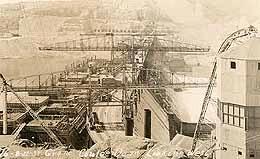On June 18, 1934, bids are opened in Spokane for the first phase of construction of Grand Coulee Dam, the centerpiece in a massive project to irrigate the desert in Central Washington with water from the Columbia River.
The bid opening was the culmination of a 16-year campaign to replicate in concrete an ice dam that had blocked the Columbia in prehistoric times. Proponents believed the dam would harness “energy that today is wasting itself away day by day” (Wenatchee Daily World, 1918). Grand Coulee Dam and the Columbia Basin Project would assert the primacy of technology over nature: What nature had made dry and barren, engineers would make green and fertile.
Concerns about the costs and doubts about the benefits kept the plans stalled for years. Private power interests predicted that the dam would glut the market with unneeded electricity. However, by the early 1930s, concerns about the high unemployment rate provided a new justification for the project. Newly elected President Franklin D. Roosevelt (1882-1945) included funding for the dam in his Public Works Administration program. However, Roosevelt balked at the scale of the overall Columbia Basin Project, which included a 550-foot main dam, several smaller dams, numerous pumping plants, and thousands of miles of canals and drainage ditches. He suggested the project be developed in stages, beginning with a smaller, lower dam that could be enlarged later, and postponing most of the work on the irrigation system.
Bids for the first stage of construction were opened in the auditorium of the Spokane Civic Building in front of a crowd of nearly 1,000. Hundreds of job seekers had crowded into the city in anticipation.
One of the bidders was the actress Mae West, who told the engineers that if they encountered any difficulties, they should “come up and see me sometime.” Only two groups met the bid specifications. The front runner was Six Companies, Inc., a group that included Kaiser Construction and the Morrison-Knudsen Company. The contract was awarded instead to a consortium known by the acronym MWAK (Silas Mason Company, Inc.; Walsh Construction Company, and Atkinson-Kier Company). The Bureau of Reclamation was the lead government agency for the project.
Work on the dam began immediately, with construction of a town to house the company’s workers. Mason City (named after Silas Mason, founder and head of the Silas Mason Company) included more than 300 houses, several dormitories, a cookhouse and dining hall that could seat 1,000, and a 33-bed hospital. The town was designed to be the world’s first “all electric city” -- a model that would demonstrate the wonders of electricity and help create a market for the power to be generated by the dam. Rent for a three-bedroom house, for those lucky enough to get one, was $32 a month.
Other towns also sprang up in the area, some with and many without the blessing of the federal government. The Bureau of Reclamation built Engineers Town to house the department’s officials, engineers, and their families. Like Mason City, it was tightly controlled by the government. Other places were more like the boom towns of the frontier era. The most infamous of these was the town of Grand Coulee, where taverns and gambling halls lined dirt streets and where prostitutes entertained customers in tents and shacks. Among the town’s nicknames were “Cesspool of the New Deal” and “Toughest Town in North America.”
By June 1935, support for a high dam and a pumping plant at Grand Coulee had increased. Secretary of the Interior Harold Ickes (1874-1952) signed a change order directing MWAK to build a foundation for a high dam. This stage of the project was completed on February 1, 1938, 14 months ahead of schedule. Pleased with the outcome, the Bureau of Reclamation authorized the completion of Grand Coulee as originally designed. The dam was topped off at 550 feet -- making it the largest concrete structure in the world -- in 1941. By that time, the entry of the United States into the war created new demands for power, accelerating the effort to expand the generating capacity at Grand Coulee. Work on the irrigation portion of the project would not resume until the early 1950s.

